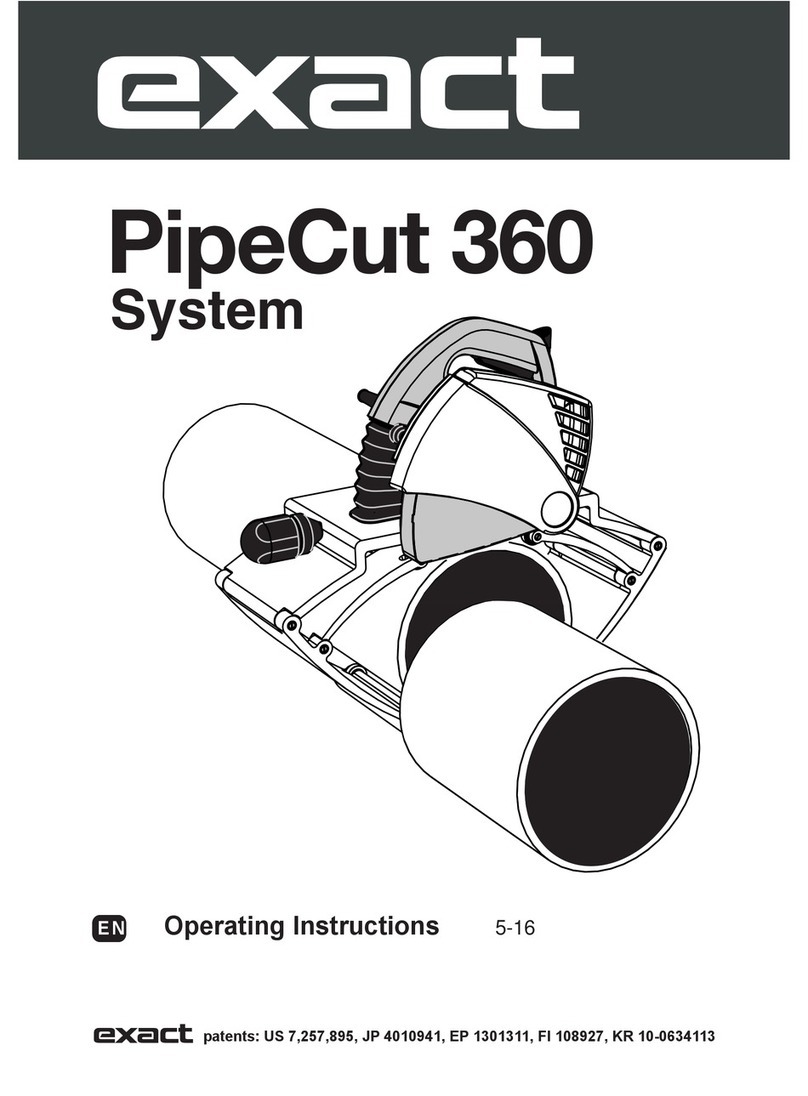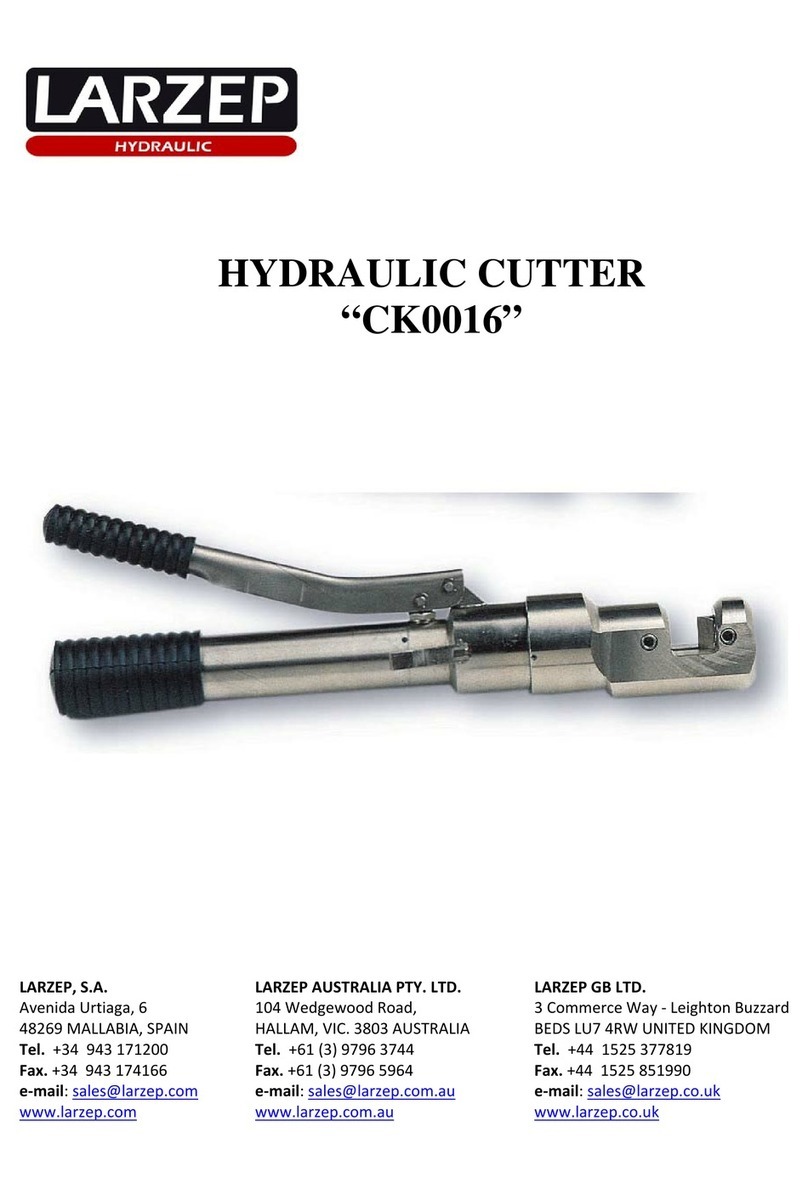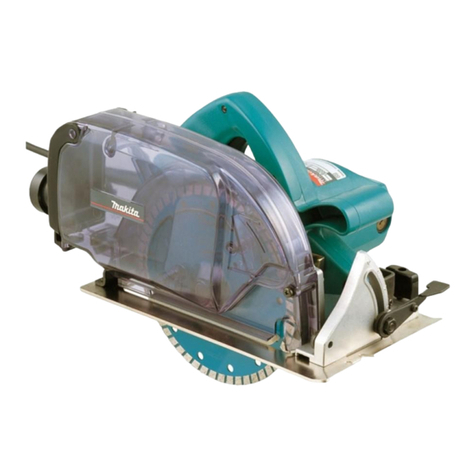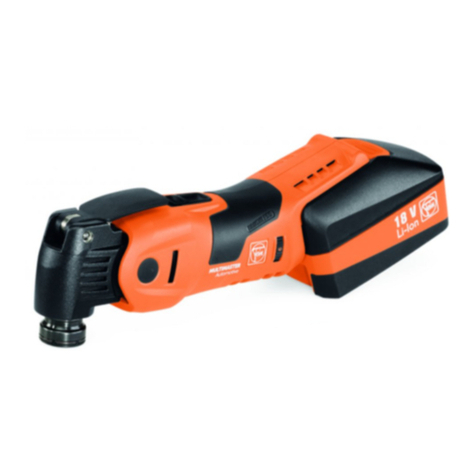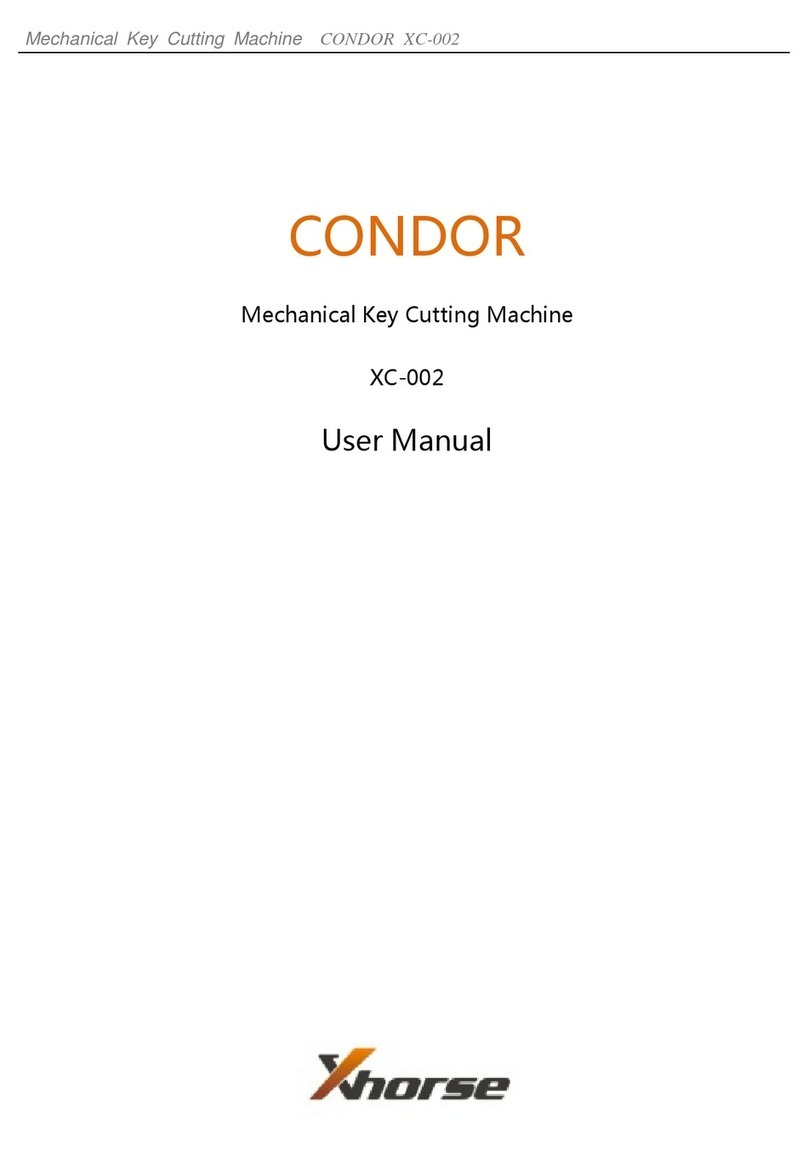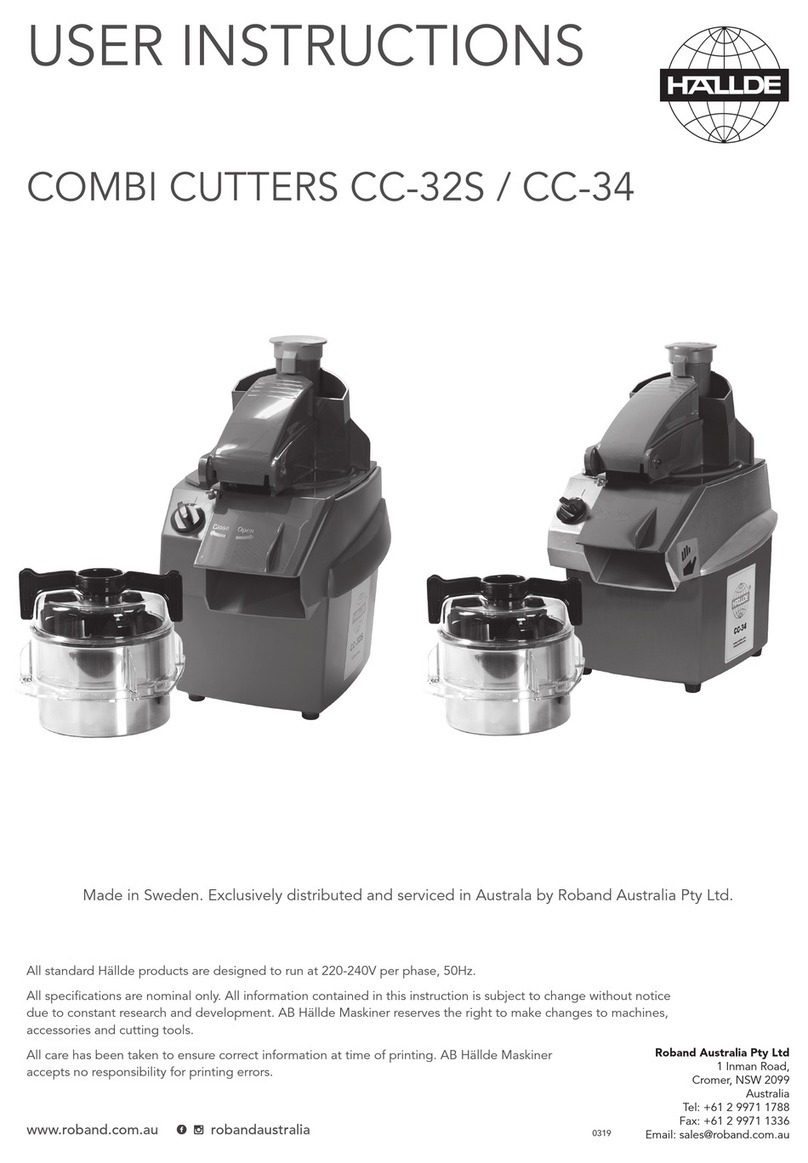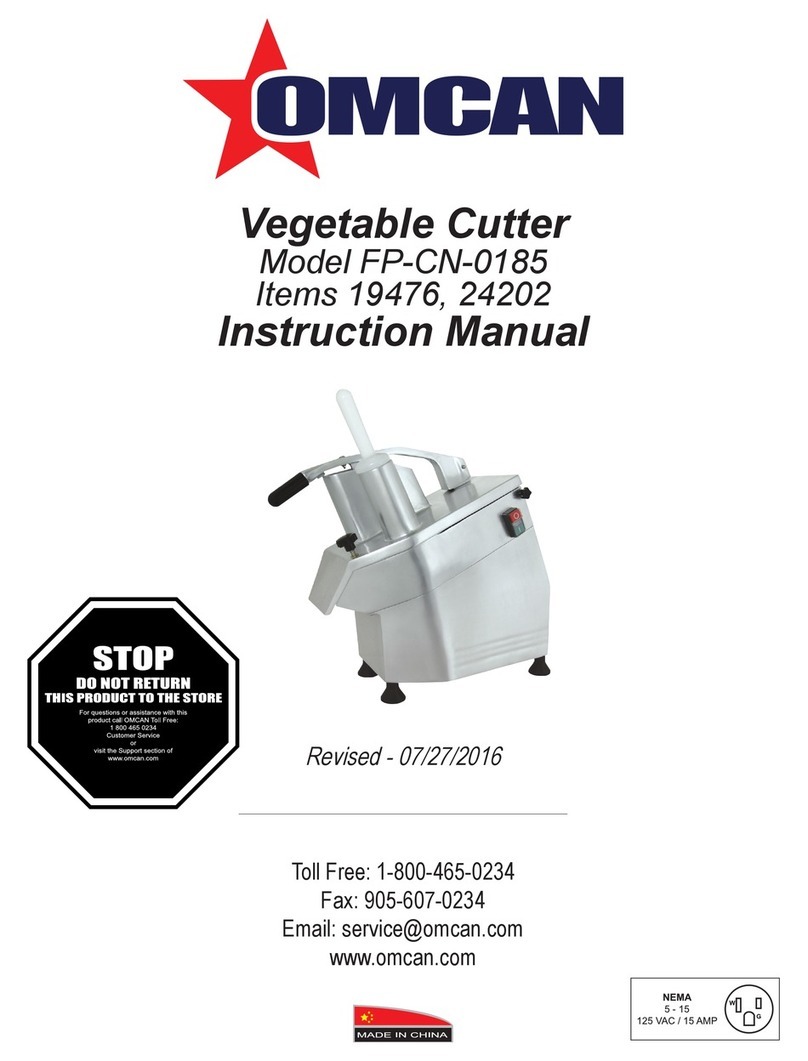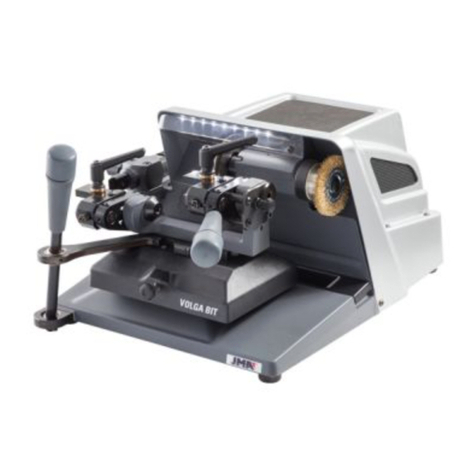eXact Pipecut 280 Pro Series User manual

English
The instructions are translated from original manual written in Finnish language available
on web-site: exacttools.com/manuals
Patents: US 7,257,895, JP 4010941, EP 1301311, FI 108927, KR 10-0634113
EN
Operating Instructions
Pipecut 280 Pro Series
/ 360 Pro Series
/ 450 Pro Series

English
2
Exact PipeCut 280 Pro Series
/ 360 Pro Series / 450 Pro Series
Data of Exact PipeCut saw blades
1. Exact TCT saw blades are for cutting steel,
copper, aluminium and all kind of plastics pipe
materials. Exact TCT saw blades can be
sharpened.
2. Exact CERMET saw blades are for cutting
stainless steel, acid proof materials, steel,
copper, aluminium and all kind of plastic pipe
materials. Exact CERMET saw blades can be
sharpened.
3. Exact CERMET ALU saw blades are for cutting
all kind of aluminum and plastic pipe materials.
Exact CERMET ALU saw blades can be
sharpened.
4. Exact TCT P blades are for cutting all kind of
plastic pipe materials. Exact TCT P saw blades
can be sharpened.
5. Exact DIAMOND X discs are for cutting Cast or
Ductile Iron only. Exact DIAMOND X discs
cannot be sharpened.
280 Pro Series / 360 Pro Series / 450 Pro Series
speed control recommendations:
Stainless steel I
Steel II
Cast-iron II
Plastics II
Declaration of Conformity
WE declare under our sole responsibility that the pipe cutting machines
Exact PipeCut 280 Pro Series / 360 Pro Series / 450 Pro Series
Described under” Technical Data” are in conformity with the following standards or standardization
documents:
IEC 62841-1:2014, IEC 62841-2-5:2014, EN 62841-1:2015, EN 62841-2-5:2014, EN 55014-1, EN 55014-2,
EN 61000-3-2, EN 61000-3-3
For more information, please contact Exact Tools at the following address:
The technical file is available at the address underneath:
The person authorized to compile the technical file:
Seppo Makkonen, chairman of the board (seppo.makkonen@exacttools.com)
Helsinki, 01.02.2018
Seppo Makkonen, chairman of the board Exact Tools Oy
Särkiniementie 5 B 64
FI-00210 Helsinki, Finland

English
3
FIGURE A
1 Unlocking switch
2 Power switch
3 Power switch locking lever
(in front of the switch)
4 Blade guard cover
5 Overload indicator light
6 Moving blade-guard
7 Adjusting screws
8 Laser pointer box
9 Adjusting wheel
10 Handle
11 Disc protection screw
12 Lock pin
13 Plate
14 Motor unit
15 Rotation speed control
16 Adjustment arrow
17 Adjustment ring
18 Adjusting button of the gripping device
19 Locking nut of the gripping device
20 Gripping device
21 Laser pointer batteries
(inside the disc protection)
22 Battery seat cover
(inside the disc protection)
23 Laser Pointer
(inside the disc protection)
24 Handle to rotate the saw
25 Laser switch

Contents
English
4
Contents
Information
5. Technical data
6. Package contents
Safety
7. Safety instructions
Operation
8. Functional description
8. Product features
9. Before operating the tool
9. Connection to the mains power supply
9. Setting the pipe on supports
9. Attaching the pipe saw to the pipe
10. Piercing the pipe wall
10. Sawing around a pipe
11. Overload protection and rotation speed control
11. Improving possible misalignment of the cut
12. Exact PipeCut 280 Pro Series / 360 Pro Series
/ 450 Pro Series cutting result adjustment
13. Installing and changing the saw blade or Diamond X Disc
13. Maintenance and servicing instructions
14. Environment /Disposal
14. Guarantee/Guarantee conditions
14. Tips for using Exact PipeCut saws
15. Extra equipment
15. Cutting depths

Information
English
5
Definitions: Safety instructions
The definitions below describe the level of severity for each signal word. Please read the manual and pay attention
to these symbols
DANGER: Indicates an imminently hazardous situation which, if not avoided, will result in serious injury or in
extreme cases a fatality
WARNING: Indicates a potentially hazardous situation which, if not avoided, could result in serious injury or
in extreme cases a fatality
CAUTION: Indicates a potentially hazardous situation which, if not avoided, may result in minor or moderate
injury.
NOTICE: Indicates a practice not related to personal injury which, if not avoided, may result
in property damage.
Denotes risk of electric shock.
Exact PipeCut 280 Pro Series / 360 Pro Series pipe saws models
Voltage 1 230 V– 240 V / 50–60 Hz tai 100 V–120 V 50–60Hz
Power 2500 W– 230 V– 240 V / 15 А-100 V– 120 V
No-load speed I (low) = 1900/min, II (high) = 2850 /min
Blade diameter 140 mm (5.6"), 165 mm (6.50"), 180 mm (7.2"),
190 mm (7.6")
Mounting bore 62 mm (2.44")
Weight 280 Pro Series 15,5 kg (34 lbs),
360 Pro Series 17,5 kg (38,6 lbs),
450 Pro Series 16,5 kg (40.7 lbs)
Range of use Ø 280 Pro Series 40 mm–280 mm (1.6"–11")
Range of use Ø 360 Pro Series 75 mm–360 mm (3.0"–16")
Range of use Ø 450 Pro Series 100 mm–450 mm (4"–17.5")
Max. Pipe wall 230V, steel, iron
20 mm / 0.78”
Max. Pipe wall 120V, steel, iron
12 mm / 0.47”
Protection class
⧈
/ II
Spindle lock Yes
Speed preselection Yes
Constant electronic control Yes
Overload Protection Yes
Reduced starting current Yes
Vibration 2,84 m/s2
LpA (sound pressure) 90,6 dB(A)
KpA (sound pressure uncertainty) 3 dB(A)
LWA (acoustic power) 103,6 dB(A)
KWA (acoustic power uncertainty) 3 dB(A)
The values given are valid for nominal voltages [U] of 230/240 V. For lower voltage and models for specific countries, these values can vary.

Information
English
6
Please observe the article number on the type plate
of your machine. The trade names of the individual
machines may vary. Only for power tools without
reduced starting current: Starting cycles generate
brief voltage drops. Interference with other
equipment/machines may occur in case of
unfavorable mains system conditions. Malfunctions
are not to be expected for system impedances
below 0.36 ohm.
Noise/vibration Information
The vibration emission level given in this information
sheet has been measured in accordance with a
standardized test given in EN60745.
Use ear protection!
Vibration level values (sum of vectors of three
directions) are defined in accordance with standard
EN60745: Vibration rate = 2.84 m/s ²,
Uncertainty K = 1,5 m/s².
The vibration emission level given in this information
sheet has been measured in accordance with a
standardized test given in EN60745 and may be
used to compare one tool with another. It may be
used for a preliminary assessment of exposure.
WARNING: The declared vibration emission
level represents the main applications of the tool.
However, if the tool is used for different applications,
with different accessories or poorly maintained, the
vibration emission may differ. This may significantly
increase the exposure level over the total working
period.
An estimation of the level of exposure to vibration
should also take into account the times when the
tool is switched off or when it is running but not
actually doing the job. This may significantly reduce
the exposure level over the total working period.
Identify additional safety measures to protect the
operator from the effects of vibration such as:
maintain the tool and the accessories, keep the
hands warm, organize work patterns.
WARNING:
Pipecut Exact PipeCut 280 Pro Series/ 360 Pro
Series
/ 450Pro Series
Use with generator or extension cords, their
minimum requirements are as follows: Generator:
minimum power of 3500 watts, if other electrical
equipment is not used at the same time.
Extension cords 230 V: The maximum length - 25
meters. Cable cross section - not less than 2,5mm ².
Extension cords 120 V: The maximum length – 82
Feet Extra Heavy Duty.
Exact PipeCut 280 Pro Series / 360 Pro Series / 450 Pro Series pipe cutting systems
Package Contents
Please check that the package contains the following items:
1. Exact PipeCut System Shoulder Bag
2. Exact PipeCut 280 Pro Series / 360 Pro Series / 450 Pro Series
pipe saw
3. Pipe Cutting supports 1 + 2 pcs.
4. Operating instructions
5. Allen key 2 pc (5 mm and 2 mm) and disc regulation key.

Safety
English
7
General power tool safety instructions
WARNING: Read all safety warnings and all
instructions. Failure to follow the warnings and
instructions may result in electric shock, fire and/or
serious injury
Save all warnings and instructions for future reference.
The term “power tool” in the warnings refers to your
mains operated (corded) power tool or battery-operated
(cordless) power tool.
1 Work area safety
a) Keep work area clean and well lit. Cluttered or dark
areas invite accidents.
b) Do not operate power tools in explosive
atmospheres, such as in the presence of flammable
liquids, gases or dust. Power tools create sparks which
may ignite the dust or fumes.
c) Keep children and bystanders away while operating
a power tool. Distractions can cause you to lose
control.
2 Electrical safety
a) Power tool plugs must match the outlet. Never
modify the plug in any way. Do not use any adapter
plugs with earthed (grounded) power took. Unmodified
plugs and matching outlets will reduce risk of electric
shock.
b) Avoid body contact with earthed or grounded
surfaces, such as pipes, radiators, ranges and
refrigerators. There is an increased risk of electric
shock if your body is earthed or grounded.
c) Do not expose power tools to rain or wet conditions.
Water entering a power tool will increase the risk of
electric shock
d) Do not abuse the cord. Never use the cord for
carrying, pulling or unplugging the power tool. Keep
cord away from heat, oil, sharp edges and moving
parts. Damaged or entangled cords increase the risk of
electric shock
e) Damaged cable should be changed in the authorized
service center.
f) When operating a power tool outdoors, use an
extension cord suitable for outdoor use.
Use of a cord suitable for outdoor use reduces the risk
of electric shock.
g) If operating a power tool in a damp location is
unavoidable, use a residual current device (RCD)
protected supply. Use of an RCD reduces the risk of
electric shock
h) Take electric tools by isolated handle, because
during the operation it can connect to flush conductor
and own cable. If tool relates to voltage-carrying
cables, voltage can pass to metal parts and it increases
the risk of electric shock.
3 Personal safety
a) Stay alert, watch what you are doing and use
common sense when operating a power tool.
Do not use a power tool while you are tired or under
the influence of drugs, alcohol or medication. A
moment of inattention while operating power tools
may result in serious personal injury.
b). Use personal protective equipment. Always wear
eye protection. Protective equipment such as dust
mask, non-skid safety shoes, hard hat, or hearing
protection used for appropriate conditions will
reduce personal injuries.
c) Prevent unintentional starting. Ensure the
switch is in the off-position before connecting to
power source, picking up or carrying the tool.
Carrying power tools with your finger on the switch
or energizing power tools that have the switch on
invites accidents.
d) Do not operate tool, if its blade/discs are not in
place.
e) Remove any adjusting key or wrench before
turning the power tool on. A wrench or a key left
attached to a rotating part of the power tool may
result in personal injury.
f) Do not overreach. Keep proper footing and
balance at all times. This enables better control of
the power tool in unexpected situations.
g) Dress properly. Do not wear loose clothing or
jewelry. Keep your hair, clothing and gloves away
from moving parts. Loose clothes, jewelry or long
hair can be caught in moving parts.
h) Do not put your hands inside the pipe during the
operation. Take care, that no one will push anything
inside the pipe during the operation.
i) Do not let your knowledge and permanent using of
instrument to affect your care. You should use
always the safety instructions. Uncaring work can
induce the serious injuries in a second.
i) Install the pipe securely. Pipe support are more
reliable for holding hold the pipe than do it by hands.
j) Do not put your hands to the waste disposal box
(vacuum cleaner connection, extra equipment).
Moving parts can cause injury.
4 Power tool use and care
a) Do not force the power tool. Dot not force the
power tool. If the power tool is forced to be used,
using is more dangerous and the quality of using is
worse.
b) Do not use the power tool if the switch does not
turn it on and off. Any power tool that cannot be
controlled with the switch is dangerous and must be
repaired.
c) Disconnect the plug from the power source from
the power tool before making any adjustments,
changing accessories, or storing power tools. Such
preventive safety measures reduce the risk of
starting the power tool accidentally.
d) Store idle power tools out of the reach of children
and do not allow persons unfamiliar with the power
tool or these instructions to operate the power tool.
Power tools are dangerous in the hands of untrained
users.
e) Keep cutting tools sharp and clean. Properly
maintained cutting tools with sharp cutting edges are
less likely to bind and are easier to control. If tool is
broken, before operation it must be repaired. Most
accidents occur as a result of poor maintenance of
tools.

Safety
English
8
f) Keep cutting tools sharp and clean. Properly
maintained cutting tools with sharp cutting edges are
less likely to bind and are easier to control.
g) Use the power tool, accessories and tool bits etc.
in accordance with these instructions, taking into
account the working conditions and the work to be
performed. Use of the
power tool for operations different from those
intended could result in a hazardous situation.
h) Keep handles and other gripping surfaces dry and
clean without oil and grease. Slim handles and other
gripping surfaces using is dangerous for the power
tool and they сomplicate tool’s using in unexpected
situations.
i) Do not use dull or damaged Disc. Blade flange
and mounting bolts are available for tool’s optimum
operating ja safety.
5 Service
Have your power tool serviced by a qualified repair
Center using only identical replacement parts. This
will ensure that the safety of the power tool is
maintained.
Further safety instructions
The pipe saw must never be used in the following
cases, if:
There is water or another liquid, explosive gases
or poisonous chemicals inside the pipe to be cut.
The power switch Is faulty.
The power cable is faulty.
The disc is bent.
The disc is blunt or in poor condition.
The plastic components are cracked or have
parts missing.
The gripper unit is not properly tightened around
the pipe or if it is warped.
The blade guard cover or moving blade guard
has been damaged or removed from the
machine.
The locking mechanisms do not work properly
(UNLOCK - SWITCH).
The pipe saw has become wet.
When you use the saw, the following factors
shall be considered:
Fasten pipes to be cut properly so that the disc is
not clamped between the ends of the pipes.
Make sure that the pipe to be cut is empty.
Make sure that the pipe is installed correctly.
Make sure that the diameter and thickness of the
disc are suitable for the saw and that the disc is
suitable for rotation speed selected
Never use help of third parties to fasten the disc,
it should move freely.
Check the parts of the disc protection.
Never apply excessive force when using pipecut.
Never use the pipecut to lift the pipe if it is fixed
on the pipe.
Avoid excessive load on the motor.
Always follow safety and operation manual and
applicable regulations.
Description of the work
Read all manuals and warnings carefully. If warnings
and instructions are not complied with, the risk of
electric shock, fire and/or severe damage to life may
occur.
Intended Use
PipeCut 280 Pro Series / 360 Pro Series
PipeCut 280 Pro Series / 360 Pro Series / 450 Pro
Series pipe saw is intended for use as a pip fitter’s
tool at the Job site.
PipeCut 280 Pro Series / 360 Pro Series / 450 Pro
Series can only be used to cut round pipes, with a
diameter of:
PipeCut 280 Pro Series 40 mm–280 mm (1.6"–11")
or 360 Pro Series: 75 mm–360 mm (3"–16")
or 450 Pro Series 100 mm–450 mm (4"–17.5")
and maximum wall thickness of 20 mm (0.4")
with steel and 50 mm (1.5") with plastics.
PipeCut 280 Pro Series / 360 Pro Series / 450 Pro
Series pipe saw can be used to cut all normal pipe
materials, such as steel, stainless steel, cast/ductile
iron, copper, aluminum and plastic.
See the cutting depth table on page 15.
PipeCut 280 Pro Series / 360 Pro Series
Is not intended for use in industrial production. Use
pipe holders to support the pipe being cut

Operation
English
9
Exact PipeCut 280 Pro Series
/ 360 Pro Series / 450 Pro Series pipe
cutting system operation instructions
Before operation the tool
- Ensure that motor unit is in the upright position.
The yellow mark of the UNLOCK SWITCH is
visible.
- Check that the disc is correctly fitted, in good
condition and suitable for the material to be cut.
- Ensure the pipe saw guide wheels rotate.
- Ensure the support wheels rotate.
- Check the operation of the lower blade guard.
- Ensure the pipe is empty.
Connection to the mains power supply
Ensure that the mains voltage is the same as
indicated on the rating plate (Fig A/13). Connect the
pipe saw to the power outlet only after having
checked the above points first.
Setting the pipe on supports
Use the system supports when cutting pipes. This
will ensure safe working and optimum results. Work
on flat surface. Place the pipe on two supports so
that the cutting point is between the supports. Place
two more support under both ends of the pipe.
Check that all support wheels contact the pipe
(adjust if required e.g. with pieces of lumber) (Fig
B/1). When cutting short and light weight pipes,
place the supports so that the cutting point is outside
supports (Fig B/2). Support the pipe with your left
leg, if required. Proper arrangements will prevent the
disc from jamming as the pipe is cut through.
Attaching the pipe saw to the pipe
Open the pipe saw's gripper unit enough to suit the
diameter of the pipe by rotating the adjustment
handle located at the rear of the saw (Fig C/1).
Position the pipe saw on top of the pipe so that the
edge of the lower blade guard is at the cutting mark.
Fasten the pipe saw to the pipe by turning the
gripper adjustment handle until the gripper grips
firmly the pipe to be cut (Fig C/2). Lock the
mechanism by turning the gripper safety (Fig C/3).
Hold the pipe in place and ensure that pipe saw
moves freely in the direction the pipe is fed. For
sake of safety ensure the pipe saw leads are to the
left of the pipe saw. The pipe saw is now ready for
cutting.
FIGURE B /1
FIGURE B /2
FIGURE C

Operation
English
10
Piercing the pipe wall
Grip the gripper firmly with your right hand and place
your left foot on top of the pipe approximately 50 cm
from the pipe saw. Turn the saw until it leans slightly
forward (Figure I). When starting the motor, first of all
release the power-switch locking lever (Fig G/1) and
push the power switch all the way down (Fig G/2).
Before starting to saw, wait until the disc reaches full
speed. Pierce the pipe wall by pressing pipe saw
operating handle downwards slowly and evenly until
the blade/disc has cut through the pipe wall (at this
stage the pipe must not rotate) and the motor unit is
locked in the sawing position (Fig I /1). Look at the
UNLOCK SWITCH during the piercing operation. When
UNLOCK SWITCH is locked, i.e. the yellow mark
disappears (Fig H),the pipe saw is locked in the sawing
position, and you can safely start sawing around the
pipe.
Sawing around the pipe
Start sawing by feeding the pipe saw forward and fix
the pipe with your left foot (Fig F/2). After that release
the pipe (remove your left foot from the pipe) and turn
the pipe saw backwards, whereby the pipe will also be
rotated backwards (Fig G). Start a new feeding
movement, and feed continuously forward ca. 1/6 of
the pipe's circumference. Repeat until the pipe is cut off
(Fig H). Select the sawing / feeding speed as per the
material and the thickness of the wall. Too high speed
can damage the blade/disc, overload the pipe saw and
give a poor sawing result.
When the pipe is cut off, push the UNLOCK SWITCH
forward until the yellow mark is visible and the locking
is released (Fig L/1). Now raise the motor unit to
starting position (Fig I/2). Release the power switch
(Fig I/3). When the blade/disc has stopped, open the
gripper safety mechanism (Fig I/4) and disengage the
pipe saw from the pipe by loosening the gripper
adjustment handle (Fig I/5). Ensure that the moving
lower blade-guard is lowered into safety position.
Should there be problems during piercing or sawing,
abnormal sounds or vibrations due to which you have
to interrupt sawing before the pipe is cut through,
release the blade/disc by pushing the UNLOCK
SWITCH forward until the UNLOCK SWITCH is
released, and lift the motor unit up. Once the problem
is cleared, start sawing again.
Never start the motor, when the motor unit is locked in
sawing the position or teeth of the blade contact the
pipe to be sawn. Ensure, that the blade/disc is not
connected to pipe during the motor operating.
FIGURE D
FIGURE E
FIGURE F
FIGURE F

Operation
English
11
Overload protector and rotation speed control
The saw has a two-speed rotation speed control (Fig
A/15). When sawing stainless or acid-proof steel use
the lower rotation speed l. When sawing other
materials use the faster rotation speed ll.
The saw also has an overload protector which
switches the power off automatically in an overload
situation. The motor part has a red indicator light
(Fig A/5).
Meaning of indicator lights (FIGURE J)
GREEN If green light is on, the motor’s
temperature and power supply are
within the norm.
Go ahead You can continue using the tools.
YELLOW If yellow light begins to flash, the
motor and power supply must be
cooled down.
Go ahead You should slow down the cutting
speed (It’s possible, that you are
using a worn-out blade/disc)
RED If the red light begins to flash, this
then automatically reduces the
current motor power to the
minimum. The Motor is still running,
but the motor power is limited to a
minimum, so that cutting process
cannot be continued.
Go ahead Press the motor switch and let it
run freely (UNDER NO LOAD) until
the green light is on.
ATTENTION! If the yellow light begins to flash
continuously, it indicates that the
motor control unit has been
damaged. You can finish the
sawing, but the saw should take out
for service. If the motor control unit
is not repaired, the motor of the saw
will be broken.
Improving possible misalignment of the cut
The cut is affected by many factors, e.g. the size of
the pipe, the material, the wall thickness, the quality
of the pipe's surface, the roundness, welded seams,
blade condition, feed rate, operator's experience.
For this reason, the saw may move to left or right
cussing unperfect cut (see Fig K).
FIGURE H
FIGURE I
FIGURE J
GO AHEAD
WARNING
RUN THE MOTOR UNTIL
GREEN LIGHT IS ON
FIGURE K
Saw has moved from right to left
Saw has moved from left to right
End of the cut
Start of the cut
End of the cut
Start of the cut

Operation
English
12
Models 280 Pro Series / 360 Pro Series / 450 Pro
Series cutting results adjustment
Within the gripping devices of these models there are
eight control wheels. One of them is the adjustment
wheel (FIGURE A/9). Please note that adjustment by
this wheel concerns only the size of one pipe and
material and the wheel may need to be adjusted again
as the saw blade or disc wears out.
Adjust the wheel by releasing the locking screw
(FIGURE L1) and turning the central part of the wheel
CLOCKWISE or ANTICLOCKWISE to obtain the
desired position (FIGURE L/2), lock the wheel again
(FIGURE L/3). If the saw is moving from right to left
(FIGURE K/a), turn the central part of the adjustment
wheel so that "d" is smaller (FIGURE K/a). If the cutting
is carried out according to Figure K/b, proceed as
shown in Fig. K/b. It is recommended to lubricate the
adjusting wheel periodically.
In these models the angle of the entire engine can be
adjusted left or right. The laser beam can be used to
ensure correct adjustment.
Adjustment stages
1. Mark the reference surface precisely on the pipe at
an angle of 90 degrees in the longitudinal direction.
2. Place the saw on the pipe so that the red line of the
laser is next to the reference value at an angle of 90
degrees. Tighten the grip to the normal tension level.
Check if the laser line and set value are at the same
level. FIGURE M/A describes the situation when the
laser bean is at different level with the reference value.
3. Release the locking screws of the adjustment plate 1
and 2 (FIGURE M/b).
4. Adjust the engine part to the right or left as needed
so that the laser beam and the value are in the same
direction. Check they are in the same direction after
adjustment.
5. Tighten the grip unit and check that the laser beam
is in one direction with the reference value set for the
pipe.
FIGURE M/c describes a situation when the laser
beam is at the same level as the reference value.
6. Tighten the locking screws of the adjustment plate
very tightly.
CAUTION! The motion sensor located in the back of the
adjustment plate does not report the exact size to
adjust. The sensor shows only the direction of
adjustment and the category of magnitude.
FIGURE L
FIGURE M /a
FIGURE M /b
Rotate wheel so that
d d was bigger
Rotate wheel so tthat
d d was smaller

Operation
English
13
FIGURE
M /c

Operation
English
14
CAUTION! If a part of the engine is regulated by the
laser, the gripping device must be attached to the pipe
with normal tension. Thus, you can be sure that the
saw fastening corresponds to the standard condition of
operation.
If you are not satisfied with the result of the work of
your saw and you need to adjust it again then always
start adjusting using the adjustment wheel.
Installing and changing the saw blade
WARNING: To reduce the risk of injury,
Turn the unit off and disconnect it from the
power source before installing and
removing accessories, before adjusting or
when making repairs. An accidental start-up
can cause injury.
Remove the power plug from the socket. Check that
the motor unit is locked in the upper position.
Remove the blade guard cover (Fig N/1) by opening
the screw (Fig N/2). Press the spindle- lock button (Fig
A/12) and simultaneously rotate the blade/disc by hand
until the spindle-lock button drops a further distance of
about 7 mm. Now the rotation of the blade/disc is
prevented. Use the blade/disc key to open the
blade/disc attachment bolt. Remove the securing bolt
(Fig N/3), the washer (Fig N/4), the blade (Fig N/5)
Before installing a new blade/disc, check that both
blade flange discs are clean. Place a new or sharpened
blade/disc on the back flange (Fig N/6), so that the
marked side of the blade/disc is facing outwards and
the arrows on the blade/disc are facing in the same
direction as the rotation direction markings on the
inside of the blade/disc case. Ensure that the new
blade/disc goes right to the bottom in the back
blade/disc flange. Put the blade flange disc, the
washer, and the securing bolt back in place. Press the
spindle lock button and tighten the blade/disc securing
bolt. Put the blade guard cover back in place and
tighten the finger bolts
FIGURE N
Maintenance and servicing instructions
Remove the power plug from the socket before
servicing or cleaning the pipe saw. All maintenance
operations carried out on the pipe saw's electrical
components must be carried out at an approved
service center or engineer
Blade/Disc
Check the condition of the blade/disc. Replace a bent,
blunt, or otherwise damaged blade/disc with a new
one. Using a blunt blade or disc can overload the pipe
saw's electric motor. When you notice that the blade or
disc is blunt do not continue sawing with it, as the
blade/disc may become so badly damaged that it will
not be worth sharpening. A blade in sufficiently good
condition can be sharpened a few times by a
professional sharpening company.Diamond X Discs
cannot be sharpened
Gripper unit
Clean the gripper unit regularly with compressed air.
Lubricate the gripper's wheel axles (Fig O/1) and its
joints (Fig O/2). Also, clean and lubricate the gripper's
trapezoidal screw (Fig O/3) and the two worm screws
on it (Fig O/4).
Blade guard
When you have sawn plastic pipes and then intend to
start sawing metal pipes always clean the inside of the
blade guards. Hot particles derived from sawing metal
will burn plastic particles, which may release toxic
smoke. Make it a rule to clean the blade guard
regularly and pay special attention to keep the moving
blade guard movement from becoming hampered.
Lubricate the axis of the moving blade guard regularly.
As an extra equipment you can buy blade
protection with connection for vacuum cleaner.
Extra equipment See page 15.
Motor
Has air vents to keep engine clean.
FIGURE O

Operation
English
15
Plastic parts
Clean the plastic parts with a soft rag. Only use mild
detergents. Do not use solvents or other strong
detergents as they may damage the plastic parts and
paint surfaces
Power cable
Check the condition of the power cable regularly. A
faulty power cable should always be replaced at an
approved service Center. Correct use and regular
servicing and cleaning will ensure the continued
operation of the pipe saw.
Environment
Separate collection. This product must not be disposed
of with normal household waste. When your Exact
PipeCut machine is worn out, do not
dispose of it with normal household waste. This product
must be recycled separately. Separate recycling of
used products and packaging facilitate recycling and
recovery of materials. Reusing of recycled materials
helps prevent pollution of the environment. According
to local regulations it is possible to deliver household
appliances to municipal rubbish depositories or to the
dealer when purchasing a new product.
Guarantee
Warranty terms valid from 01.01.2018. If the Exact
PipeCut saw becomes unusable due to material or
manufacturing defects within the Warranty Term at our
discretion we will repair the Exact PipeCut Saw or
supply an entirely new or factory reconditioned Exact
PipeCut Saw at no charge.
The Exact Tools Warranty Term is for 12 months from
date of purchase.
The Warranty is only valid if:
1.)Copy of a dated purchase receipt is returned to the
Authorized Warranty Repair Center or has been
uploaded to our website at the time of warranty
registration.
2.)The Exact PipeCut Saw has not been misused.
3.)No attempt has been made by non-approved
persons to repair the saw.
4.)The Exact PipeCut Saw has been used in
accordance with the operating, safety, and servicing
instructions provide in the manual.
5.)The Exact PipeCut Saw has been delivered to an
Authorized Warranty Repair Center within the term
of the warranty.
NOTICE! The Exact PipeCut Saw is to be shipped to
the Authorized Warranty Repair Center freight
prepaid. If the Exact PipeCut Saw is repaired under
Warranty the return shipment will be made freight
prepaid.
CAUTION!
The following items or services are excluded for
Warranty claims:
- Saw Blades
- Carbon Brushes
- Gripping Unit Wheels
- Attachment Flange
- Pulling Flange Washer
- Normal Wear
- Errors Due to Misuse or Accident
- Water, Fire and Physical Damage
- Cables
- Adjustment of Adjustment Wheel
- If a wrong type of generator has been used as
power source.
Exact Pipe Cut operation tips
Diamond blade can only be used for cutting cast or
ductile iron pipes. This pipe material is not
recommended to attempt to cut using to a saw blade of
any type
Clean the inside of the blade guards after cutting
plastic pipes.
The smaller pipe is easier to cut by turning the pipe
manually either on the table or on the floor.
CAUTION! Turn the pipe towards yourself when you do
it manually. Don't turn the pipe too fast.
Check the condition of the pipe regularly.
The cutting process is divided into two stages: first you
need to cut the pipe wall, then cut around the pipe
Do not overload the saw while working without
interruption. The pipecut will overheat and metal parts
can become very hot. In this case, the motor and
blades/discs may also become damaged. Use the
pipecut system in accordance with it’s duty cycle being
continuous cutting 2.5 minutes, then let it cool under no
load for 7.5 minutes.
Maintain a uniform feed speed rate. This increases
the lifespan of the disc. For example a steel pipe
thickness with an O/D diameter 170 mm (6') and wall
thickness-5 mm (1/5'), the cutting time-is15-20
seconds, and accordingly, with a diameter of 4 ' (110
mm) and wall thickness of 1/6 ' ' (4 mm) the cutting
time of cast iron pipe-is 20 – 25 seconds.
.

Environment, Guarantee, Tips
English
16
Title
Factors Influencing the Blade/Disc lifespan:
Pipe material
Combination of disc type with cutting material
Correct motor speed setting
Pipe wall thickness
Feed rate
Smoothness of the pipe
General user knowledge
Cleanliness of the pipe
Corrosion on pipe
welded seam on the pipe
Blade/Disc speed
Factors influencing straightness of cutting:
Blade/Disc condition
Pipe wall thickness
Feed speed rate
Uniformity of feed
General user knowledge
Cleanliness of the pipe
Pipe circumference
Too loose or tightened gripping device
Too tightened blade/disc
Extra equipment 280 – 360 – 450 PS
Blade/Discs
Exact TCT: Suitable for cutting steel and all kinds of
plastic pipe material
Exact Cermet: Suitable for cutting stainless steel
and acid proof materials, steel, copper, aluminium
and all kind of plastic pipe materials.
Exact ALU: Suitable for cutting aluminum and all
kinds of plastic.
Exact Diamond: Suitable only for cutting cast and
duct iron pipe materials. Also for cutting concrete
lined cast iron pipes.
Exact TCT 140
Exact Cermet 140
Exact ALU 140
Exact Diamond X 140
Exact TCT 165
Exact Cermet 165
Exact ALU165
Exact Diamond X 165
Exact Cermet 180
Exact ALU 180
Exact Diamond X 180
Exact ALU 190
Protection cover with vacuum cleaner connection.
FIGURE P
Due to the continuous improvement of the products,
the present manual may be modified. No changes
will be reported separately.
For more information check
www.exacttools.com
Theoretical cutting depths
280 PS Max. pipe wall / mm,
With pipe diameters
140, 165, 180, 190
360 PS Max. pipe wall / mm,
With pipe diameters 140, 165, 180, 190
OD / mm 140
165
180
190
OD / mm 140
165
180
190
50
5,3
17,8
25,3
30,3
50
–
–
–
–
75
4,9
17,4
24,9
29,9
75
21,6
34,1
41,6
46,6
100
6,1
18,6
26,1
31,1
100
16,4
28,9
36,4
41,4
110 6,8
19,3
26,9
31,9
110 15,6
28,4
35,6
40,6
115
7,2
19,8
27,2
32,2
115
15,3
27,8
35,3
40,3
140
9,5
22
29,5
34,5
140
14,9
27,4
35
40
165 12
24,5
32
37
165 15,5
28
35,5
40,5
215
17,2
29,8
37,2
42,2
215
18
30,5
38
43
270
22,6
35,1
42,6
47,6
270
21,6
34,1
41,6
46,6
320
–
–
–
–
320
24,9
37,4
44,9
49,9
355 –
–
–
–
355 26,7
39,2
46,7
51,7

Extra equipment
, cutting
d
epth
s
русский
Max. pipe wall thicknesses in different pipe materials,
which can be cut by Exact 280 Pro Series and Exact 360
Pro Series
European model 230V / 2500W
Steel pipes
Max.pipe wall thickness 20 mm / 0.78”
Stainless steel pipes
Max.pipe wall thickness 20 mm / 0.78”
Iron pipes
Max.pipe wall thickness 20 mm / 0.78”
Any on plastic, aluminium, cooper
Pipe wall thickness of these pipes is not limited
USA model 120V / 15A
Steel pipes
Max.pipe wall thickness 12 mm / 0.47”
Stainless steel pipes
Max.pipe wall thickness 12 mm / 0.47”
Cast or Ductile Iron pipes
Max.pipe wall thickness 12 mm / 0.47”
Any Types of plastic, aluminium, cooper
Pipe wall thickness of these pipes is not limited
ATTENTION!
Do not cut thicker pipe walls, than the above mentioned.
ATTENTION!
Check the status and condition of the pipe before using the saw
Other manuals for Pipecut 280 Pro Series
1
This manual suits for next models
2
Table of contents
Other eXact Cutter manuals
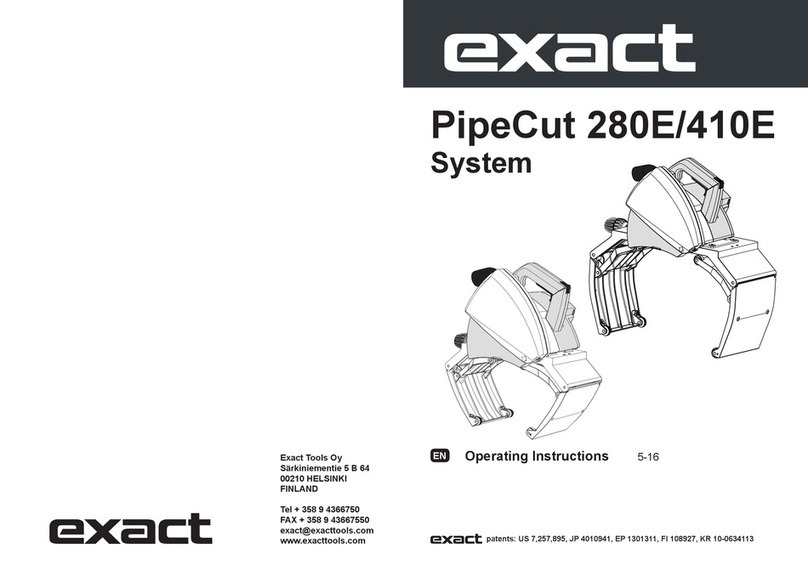
eXact
eXact PipeCut 410E User manual

eXact
eXact PipeCut 280E System User manual

eXact
eXact PipeCut+Bevel 170E User manual
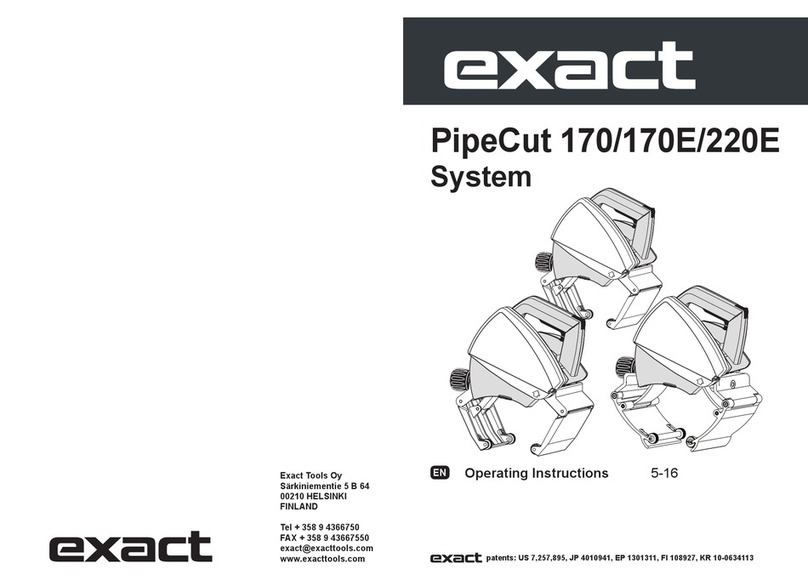
eXact
eXact PipeCut 170 User manual
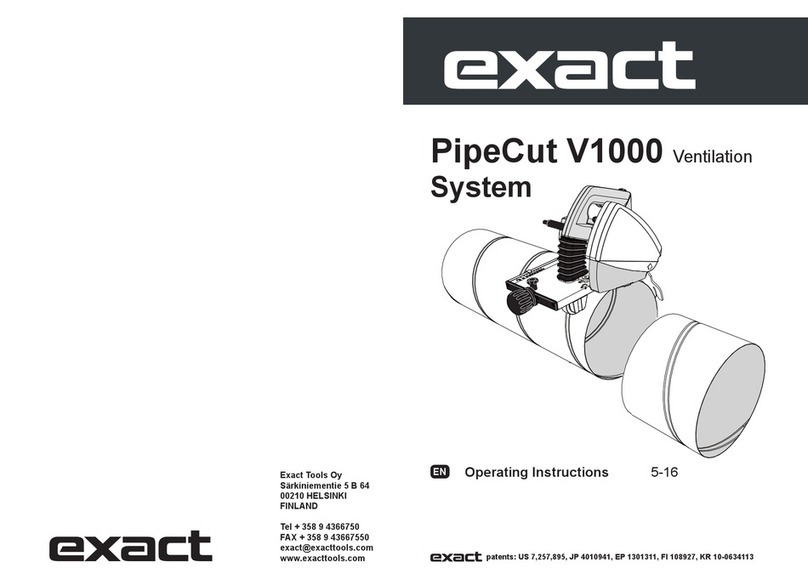
eXact
eXact PipeCut V1000 User manual
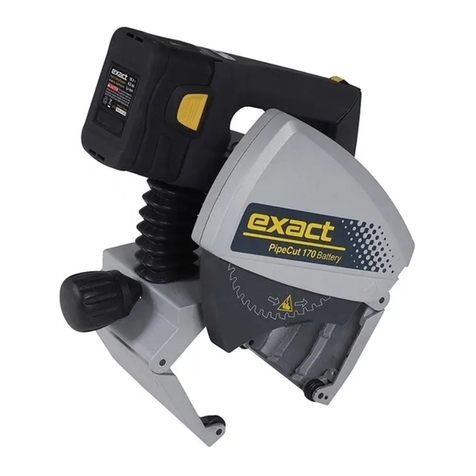
eXact
eXact PipeCut 170 User manual

eXact
eXact PipeCut 170 User manual
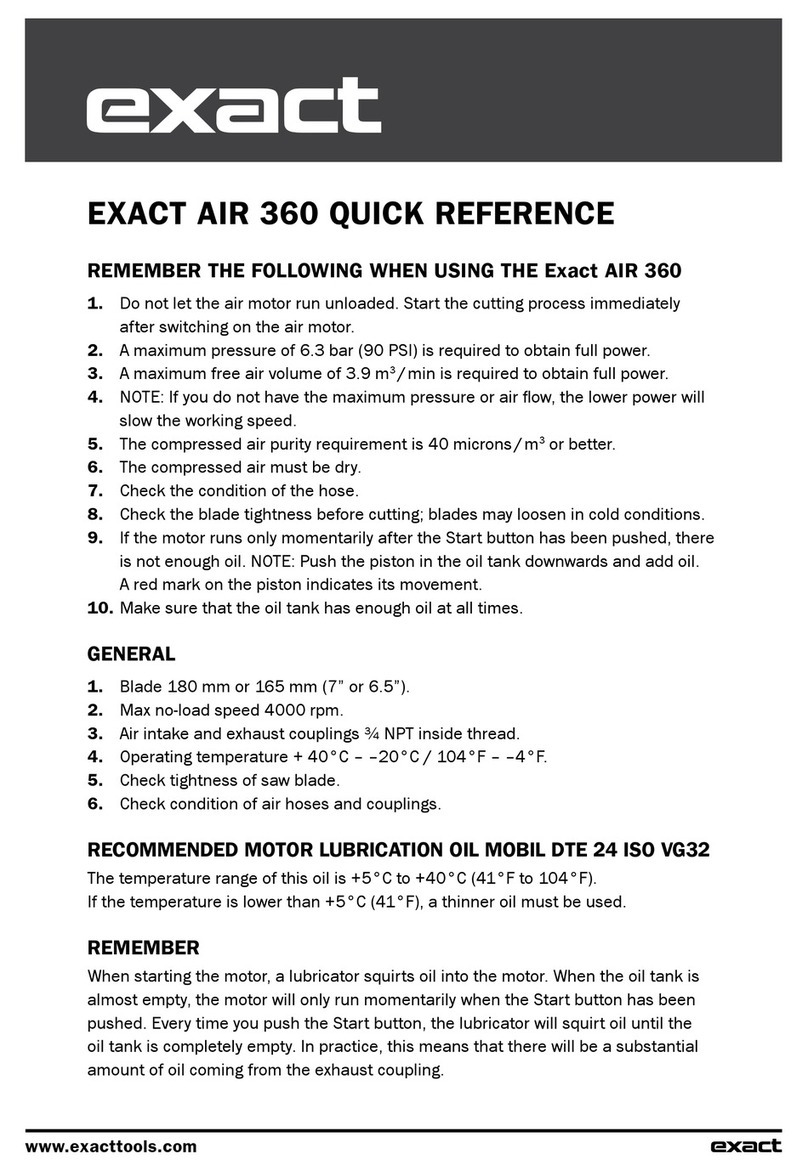
eXact
eXact AIR 360 User manual
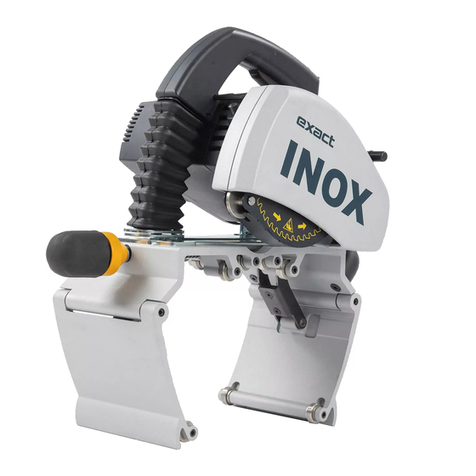
eXact
eXact PipeCut 220 INOX Series User manual
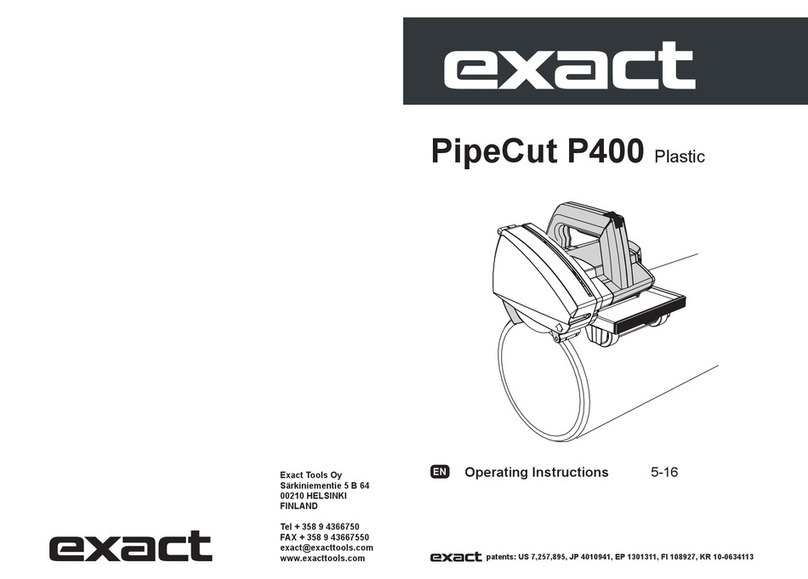
eXact
eXact PipeCut P400 User manual
